The production indicators of geomembrane usually include the following aspects:
Thickness: The thickness of the geomembrane refers to its thickness on the horizontal plane, generally in millimeters (mm) as the unit. According to different engineering requirements, the thickness of the geomembrane can vary.
Tensile strength: The tensile strength of a geomembrane refers to the maximum force that a material can withstand during stretching. It is generally expressed in megapascal (MPa) as a unit.
Elongation at break: The elongation at break of a geomembrane indicates the tensile properties of the material when subjected to a tensile force, that is, the percentage that can be extended before failure.
Stiffness: The stiffness of a geomembrane refers to the ability of a material to resist deformation due to external forces, and is generally measured by a stiffness factor or a deflection index.
Chemical resistance: The geomembrane needs to have good chemical resistance and be able to resist chemical corrosion to ensure long-term and stable use.
Density: The density of a geomembrane refers to the ratio of the mass to volume of the material, usually in grams per cubic centimeter (g/cm³).
Thermal aging performance: Geomembranes need to have good thermal aging stability, and be able to maintain their physical properties and service life in long-term high-temperature environments.
Anti-permeability: The anti-permeability of geomembrane refers to its ability to prevent the penetration of liquid or gas, which is generally measured by the permeability coefficient.

What is the tensile strength of geomembrane
The tensile strength of a geomembrane refers to the maximum force it can withstand during stretching. Tensile strength is usually expressed in megapascals (MPa).
The tensile strength of geomembranes varies with different types and thicknesses.
Generally speaking, the tensile strength of high-density polyethylene (HDPE) geomembranes ranges from 15 MPa to 40 MPa, and the tensile strength of linear low-density polyethylene (LLDPE) geomembranes ranges from 10 MPa to 25 MPa, while linear high Density polyethylene (LDPE) geomembranes have a lower tensile strength range, typically 5 MPa to 15 MPa.

What is the elongation at break of geomembrane
The elongation at break of a geomembrane refers to the tensile properties of the material when subjected to a tensile force, that is, the percentage that can be extended before failure.
Different types and thicknesses of geomembranes will have different elongation at break. Generally speaking, the elongation at break of high-density polyethylene (HDPE) geomembranes is usually between 500% and 700%, while the elongation at break of linear low-density polyethylene (LLDPE) geomembranes is generally above 700%.


